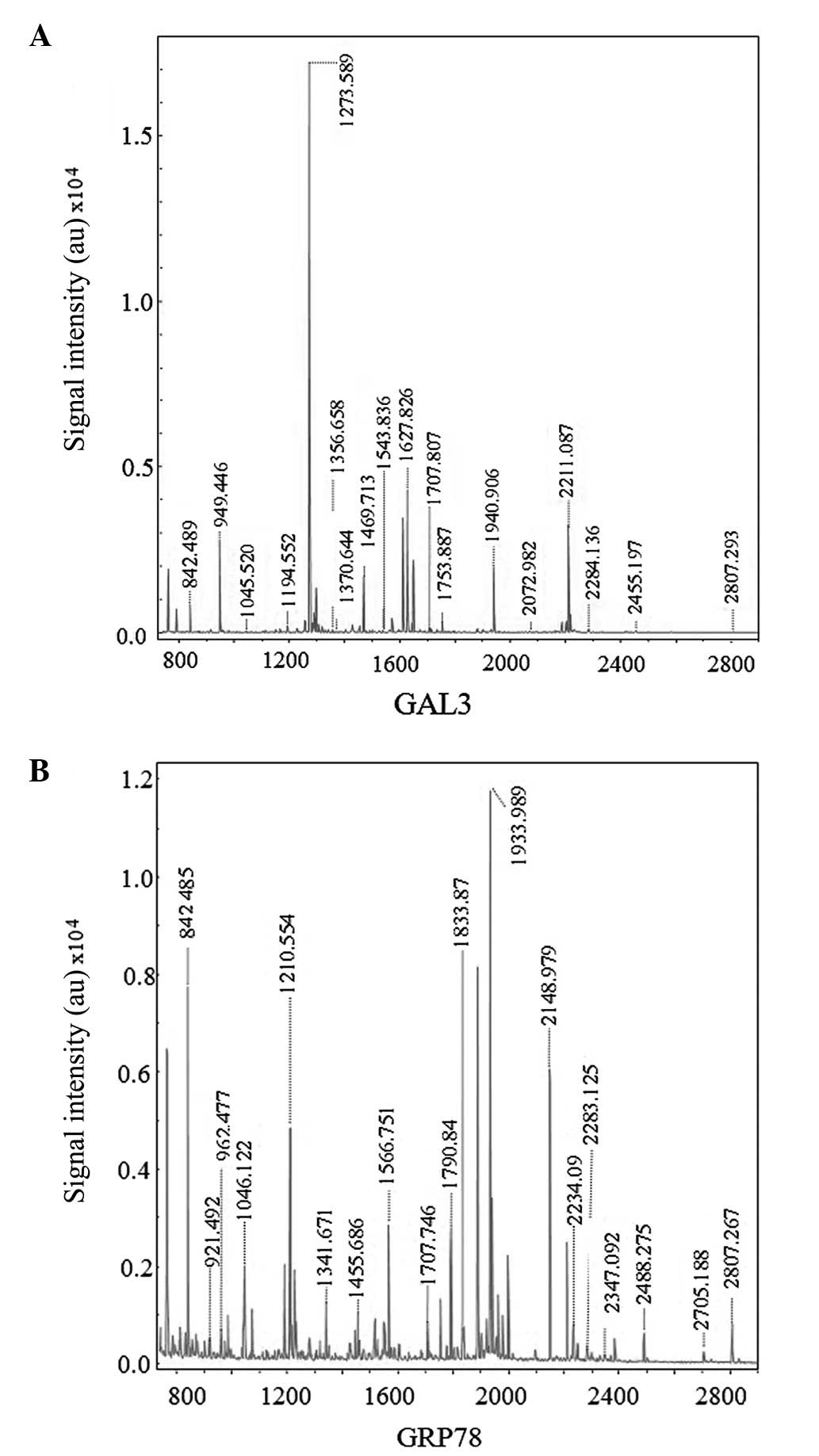GRP78 and GAL3, differentially regulated by lymph node homogenates, as potential biomarkers for lymph node metastasis in mouse hepatocellular carcinoma cells
- Authors:
- Wenjun Zhu
- Lawrence Owusu
- Shizhu Zang
- Yunjuan Zhang
- Yi Xin
- Chao Yan
-
View Affiliations
Affiliations: Department of Biotechnology, Dalian Medical University, Dalian, Liaoning116044, P.R. China, School of Pharmacy, Shanghai Jiao Tong University, Shanghai 200240, P.R. China
- Published online on: September 13, 2012 https://doi.org/10.3892/ol.2012.915
-
Pages:
1374-1378
Metrics:
Total
Views: 0 (Spandidos Publications: | PMC Statistics:
)
Metrics:
Total PDF Downloads: 0 (Spandidos Publications: | PMC Statistics:
)
This article is mentioned in:
Abstract
In order to systematically evaluate the influence of lymph nodes (LNs) in lymph node metastases (LNM) of hepatocellular carcinoma (HCC), we set up a new in vitro model in which Hca‑F and Hca‑P cells were cultured in medium containing lymph node homogenates (LNHs). Differential protein expression was measured by two‑dimensional gel electrophoresis (2‑DE) combined with matrix‑assisted laser desorption/ionization time‑of‑flight/time‑of‑flight mass spectrometry (MALDI TOF/TOF MS). Results from protein identification revealed two metastatic correlative proteins, 78-kDa glucose‑regulated protein (GRP78) and galectin-3 (GAL3). Western blotting confirmed that GRP78, a protein positively correlated with metastasis, increased 2.4‑fold in Hca‑F cells but decreased to almost a half in Hca‑P cells (P<0.05). However, GAL3, a protein negatively correlated with metastasis, was decreased by a half in Hca‑F cells but slightly increased non‑significantly in Hca‑P cells. Thus, our results reveal that some components of LNHs may facilitate a permissive environment for cancer cells with high metastasis potential to eventually metastasize. GRP78 and GAL3 may serve as potential biomarkers for the diagnosis of LNM in HCC.
View References
|
1.
|
DM ParkinGlobal cancer statistics in the
year 2000Lancet Oncol2533543200111905707
|
|
2.
|
VO MelnikovaM Bar-EliInflammation and
melanoma metastasisPigm Cell Melanoma
Res22257267200910.1111/j.1755-148X.2009.00570.x19368690
|
|
3.
|
H ChuH ZhouY LiuY HuJ ZhangFunctional
expression of CXC chemokine recepter-4 mediates the secretion of
matrix metalloproteinases from mouse hepatocarcinoma cell lines
with different lymphatic metastasis abilityInt J Biochem Cell
Biol39197205200710.1016/j.biocel.2006.07.008
|
|
4.
|
H ZhouL JiaS WangH WangH ChuY HuJ CaoJ
ZhangDivergent expression and roles for caveolin-1 in mouse
hepatocarcinoma cell lines with varying invasive abilityBiochem
Biophys Res
Commun345486494200610.1016/j.bbrc.2006.03.24616684506
|
|
5.
|
B SongJW TangB WangXN CuiL HouL SunLM
MaoIdentify lymphatic metastasis-associated genes in mouse
hepatocarcinoma cell lines using gene chipWorld J
Gastroenterol1114631472200510.3748/wjg.v11.i10.146315770722
|
|
6.
|
RR LangleyIJ FidlerThe seed and soil
hypothesis revisited - the role of tumor-stroma interactions in
metastasis to different organsInt J
Cancer12825272535201110.1002/ijc.2603121365651
|
|
7.
|
RG BagleyThe Tumor
MicroenvironmentSpringer Science + Business MediaNew
York201010.1007/978-1-4419-6615-5
|
|
8.
|
L JiaS WangH ZhouJ CaoY HuJ
ZhangCaveolin-1 upregulates CD147 glycosylation and the invasive
capability of murine hepatocarcinoma cell linesInt J Biochem Cell
Biol3815841593200610.1016/j.biocel.2006.03.01916702020
|
|
9.
|
JD YangI NakamuraLR RobertsThe tumor
microenvironment in hepatocellular carcinoma: current status and
therapeutic targetsSemin Cancer
Biol213543201110.1016/j.semcancer.2010.10.00720946957
|
|
10.
|
C JollyRI MorimotoRole of the heat shock
response and molecular chaperones in oncogenesis and cell deathJ
Natl Cancer Inst9215641572200010.1093/jnci/92.19.156411018092
|
|
11.
|
S LuoC MaoB LeeAS LeeGRP78/BiP is required
for cell proliferation and protecting the inner cell mass from
apoptosis during early mouse embryonic developmentMol Cell
Biol2656885697200610.1128/MCB.00779-0616847323
|
|
12.
|
JM LukCT LamAFM SiuBY LamIO NgM HuCM CheST
FanProteomic profiling of hepatocellular carcinoma in Chinese
cohort reveals heat-shock proteins (Hsp27, Hsp70, GRP78)
up-regulation and their associated prognostic
valuesProteomics610491057200610.1002/pmic.20050030616400691
|
|
13.
|
D DongC StapletonB LuoA critical role for
GRP78/BiP in the tumor microenvironment for neovascularization
during tumor growth and metastasisCancer
Res7128482857201110.1158/0008-5472.CAN-10-315121467168
|
|
14.
|
K OkadaT ShimuraT SuehiroE MochikiH
KuwanoReduced galectin-3 expression is an indicator of unfavorable
prognosis in gastric cancerAnticancer Res2613691376200616619546
|
|
15.
|
IJ FidlerSJ KimRR LangleyThe role of the
organ microenvironment in the biology and therapy of cancer
metastasisJ Cell Biochem101927936200710.1002/jcb.2114817177290
|
|
16.
|
IJ FidlerThe organ microenvironment and
cancer
metastasisDifferentiation70498505200210.1046/j.1432-0436.2002.700904.x12492492
|
|
17.
|
S PagetThe distribution of secondary
growths in cancer of the breast 1889Cancer Metastasis
Rev89810119892673568
|













